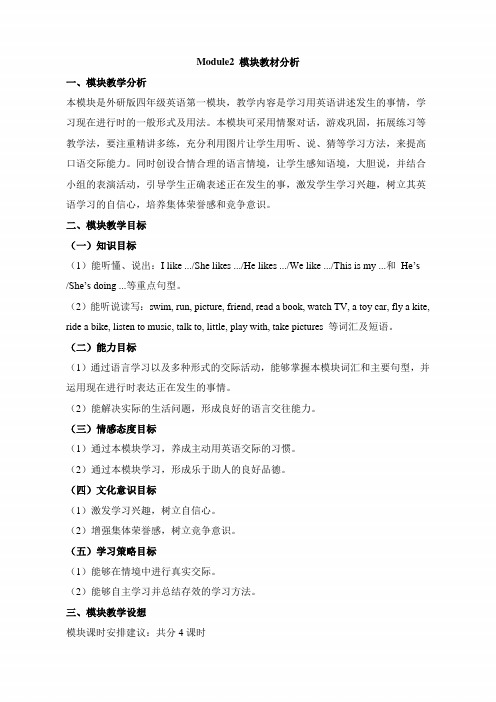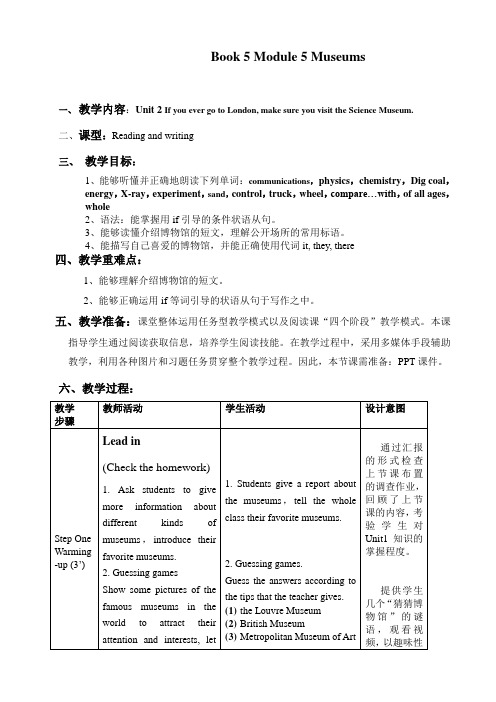Book 5Module2教案
- 格式:doc
- 大小:78.50 KB
- 文档页数:2

外研版(一起)二年级英语上册《Module 2 Unit 2》教案设计一、教学目标1. 知识与技能目标:学生能够听懂、会说、会读本课的单词和句子;学生能够理解并在实际情景中运用句型“Can I ?”和“Yes, you can./ No, you can’t.”;学生能够理解一般疑问句的意义和用法。
2. 过程与方法目标:通过听、说、读、写的活动,培养学生的英语听说能力和阅读能力;通过小组合作和角色扮演,培养学生的合作能力和表达能力。
3. 情感态度与价值观目标:激发学生学习英语的兴趣和积极性;培养学生的自信心和自主学习能力;培养学生尊重他人、礼貌待人的良好品质。
二、教学内容1. 词汇:ball, toy, bag, book, ruler, pencil, pen, pencilcase, crayon, tape, scissors, gluestick, eraser, Sharpener, can, can’t。
2. 句型:Can I ?Yes, you can./ No, you can’t.3. 功能:询问并回答是否可以做某事。
三、教学重点与难点1. 教学重点:词汇的学习和记忆;句型的理解和运用。
2. 教学难点:一般疑问句的意义和用法;词汇的发音和书写。
四、教具与学具准备1. 教具:PPT、录音机、教学卡片、黑板、粉笔。
2. 学具:英语课本、练习本、铅笔、彩色笔。
五、教学过程1. 导入:通过唱英文歌曲或做游戏,激发学生的学习兴趣,营造轻松愉快的学习氛围。
2. 新课展示:通过PPT展示本课的词汇和句型,让学生听录音并跟读,帮助学生理解并记忆。
3. 操练:通过小组合作和角色扮演,让学生在实际情景中运用本课的词汇和句型,培养学生的合作能力和表达能力。
4. 巩固:通过听、说、读、写的活动,巩固学生对本课词汇和句型的理解和运用。
六、板书设计1. Module 2 Unit 22. 词汇:ball, toy, bag, book, ruler, pencil, pen, pencilcase, crayon, tape, scissors, gluestick, eraser, Sharpener, can, can’t.3. 句型:Can I ?Yes, you can./ No, you can’t.七、作业设计1. 听力练习:听录音,选择正确的图片。

Module2 模块教材分析一、模块教学分析本模块是外研版四年级英语第一模块,教学内容是学习用英语讲述发生的事情,学习现在进行时的一般形式及用法。
本模块可采用情聚对话,游戏巩固,拓展练习等教学法,要注重精讲多练,充分利用图片让学生用听、说、猜等学习方法,来提高口语交际能力。
同时创设合情合理的语言情境,让学生感知语境,大胆说,并结合小组的表演活动,引导学生正确表述正在发生的事,激发学生学习兴趣,树立其英语学习的自信心,培养集体荣誉感和竞争意识。
二、模块教学目标(一)知识目标(1)能听懂、说出:I like .../She likes .../He likes .../We like .../This is my ...和He’s /She’s doing ...等重点句型。
(2)能听说读写:swim, run, picture, friend, read a book, watch TV, a toy car, fly a kite, ride a bike, listen to music, talk to, little, play with, take pictures 等词汇及短语。
(二)能力目标(1)通过语言学习以及多种形式的交际活动,能够掌握本模块词汇和主要句型,并运用现在进行时表达正在发生的事情。
(2)能解决实际的生活问题,形成良好的语言交往能力。
(三)情感态度目标(1)通过本模块学习,养成主动用英语交际的习惯。
(2)通过本模块学习,形成乐于助人的良好品德。
(四)文化意识目标(1)激发学习兴趣,树立自信心。
(2)增强集体荣誉感,树立竞争意识。
(五)学习策略目标(1)能够在情境中进行真实交际。
(2)能够自主学习并总结存效的学习方法。
三、模块教学设想模块课时安排建议:共分4课时第一课时:Unit1 She’s reading a book.1. Listen, point and say.2. Listen, point and find“-ing”第二课时:Unit1 She’s reading a book.3. Listen and say.4. Practise.第三课时Unit 2 What are you doing?1. Listen and chant.2. Listen and say.3. Listen and match. Then say.第四课时:Unit 2 What are you doing?4. Listen and say. Then sing and do the actions.5. Mime, ask and answer.6. Do and say.。

Book5 M2 导学案第一课时-----基础训练一。
课文复习A根据课文内容填空Roads can be in____________and dangerous ____________(在高纬度)in big mountains . Let me tell you something about one road in La Paz , which is at 3,500meters in Bolivia, and a man who is always standing __________of the road_______________.___________, mountains rise _______and on the other there is_____________. Often the vehicles ________the road and fall. You can imagine how many people ___________ ______________ death there .The most dangerous thing is that there is a bend where two vehicles from___________________can’t see each other. But _____to TImoteo , ___________has fallen . Every morning , he ___________the bend with a large board , which is red on one side and green on the other. When vehicles e , he shows the drivers the board , which tells them to ________the green color or to stop with the red color .In this way he directs the traffic . YOU may think his job is________. How much money does he receive from doing it ? Nearly nothing . He is a volunteer. Only a few drivers give him______, which helps him to____________. Most of them _____________. Why does he do so ?It’s because he thinks it his ____________to help others.B.重点句子----完成下列句子。

Book 5 Module 5 Museums一、教学内容:Unit 2 If you ever go to London, make sure you visit the Science Museum.二、课型:Reading and writing三、教学目标:1、能够听懂并正确地朗读下列单词:communications,physics,chemistry,Dig coal,energy,X-ray,experiment,sand,control,truck,wheel,compare…wit h,of all ages,whole2、语法:能掌握用if引导的条件状语从句。
3、能够读懂介绍博物馆的短文,理解公开场所的常用标语。
4、能描写自己喜爱的博物馆,并能正确使用代词it, they, there四、教学重难点:1、能够理解介绍博物馆的短文。
2、能够正确运用if等词引导的状语从句于写作之中。
五、教学准备:课堂整体运用任务型教学模式以及阅读课“四个阶段”教学模式。
本课指导学生通过阅读获取信息,培养学生阅读技能。
在教学过程中,采用多媒体手段辅助教学,利用各种图片和习题任务贯穿整个教学过程。
因此,本节课需准备:PPT课件。
六、教学过程:达标训练题QuizⅠ. 用方框里的词的适当形式完成句子。
sand control energy truck chemistry1. With growth, demand for ________ continues to rise.2. Look over there! The kids are playing with ________ on the beach.3. I’m afraid that the ________ isn’t large enough to carry all the things.4. __________ was her favorite subject at school.5. It’s difficult to _______ an aircraft a t high school.Ⅱ. 根据要求完成下列句子。

外研社版八年级英语上册Module 5 Unit 2 It describes the changes in Chinese Society.【教材分析】本模块以老舍以及老舍茶馆为主题,介绍了作家老舍、老舍茶馆以及话剧《茶馆》等相关内容,共三个单元。
第一单元为听说课,以玲玲带贝蒂前往老舍茶馆观看京剧为主题展开的对话。
本课时是第二单元第一课时,为阅读课,以介绍著名作家老舍、其作品《茶馆》和北京老舍茶馆为主要内容。
通过设置读前、读中、读后三个阶段的教学活动,学生可以学会通过观察短文段落标题来把握文章大意,培养阅读策略,并引导学生通过建立时间轴来表现人物的生平,借此把握文章脉络,充分提取细节信息。
通过对老舍及其生平和作品的了解,增强对中国传统文化的热爱,增强民族自豪感。
【学情分析】本单元的话题贴近学生生活,内容是通过对作家老舍,戏剧《茶馆》和景点老舍茶馆了解,形成有效的语言输出,完成任务,让学生了解有关传统文化的主题。
在教学中反复使用词汇及句型,以不同形式反复出现,在足够的输入中达成有效的语言输出。
八年级学生,他们活泼、开朗,对学习英语有着强烈的兴趣,但注意力容易分散,有不稳定性的生理特点。
教学中注意启发引导,更要注重教学方法的灵活性,因此,通过任务型教学法、情景交际教学法和学生小组合作、小组竞争等不同形式来激发学生。
【教学目标】1.过图片和语境帮助学生学习新单词和短语。
2.借助段落标题和照片,使学生理解文章主要意思。
3.通过时间轴来记录事件的发展顺序。
4.进一步培养学生爱国情怀,弘扬传统文化的品格。
【教学重难点】重点:本单元单词、短语和文章主要意思。
难点:用时间轴记录事件发展顺序。
【教学过程】Step 1: Lead-inTeacher shows learning objectives, let students get aims of this class. Ask students questionsQ1:Do you like watching movies?Q2:Do you know the movie and did you see the movie?(展示学习目标,让学生明确本节课学习内容,再看图片,引入电影《我和我的祖国》,即激发学生兴趣,又设定情景,开展情景教学。

Unit 2 How much cheese did you buy?第二课时课时内容4.Listen and repeat.,6.Do and say.& 7.Now write and act.课时分析本课时是外研版三起点五年级上册第二模块第二单元第二课时。
五年级学生,学生的年龄大多为10—12岁,紧紧抓住学生的年龄特点,因势利导,循循善诱,使其在营造的浓厚的英语环境中大胆地学习和使用英语,以提高综合运用英语的能力。
通过在英语课堂中的教学,能让学生融入到说英语的氛围中去,体会学英语的乐趣。
本课时是第二模块第二单元的第2课时,本课时学习Unit 2 Activities 4、6&7。
这部分内容主要是复习与巩固词汇use、half、bottle、kilo、over there、a lot of和句型“How many/much...did you buy?”同时本课时要求学生学习元音字母u、o、a和字母组合er、ir及ur的发音。
本课时包括Listen and repeat.,Do and say.和Now write and act.两个板块。
Listen and repeat.该版本是对语音的学习,我们要根据字母u,o, a,er, ir, ur的发音能对该类单词正确的发音,根据字母u, o的发音规则学会带有u, o的单词的发音,根据字母a,er的发音规则准确地读出含有字母a,er的单词,通过学习字母ir,ur的发音,来准确地对含有字母ir,ur的单词进行准确的发音;Follow and say.呈现了小朋友们的购物经历,此情境也因为贴近学生的实际生活,然后结合Now write and act.一起,更能激发学生学习英语的兴趣。
Now write and act.板块在使用我们学过对话What did you buy at the supermarket?I bought...和How many/much (i)you buy? A kilo.,从而做到了学以致用。
Unit 2Can Sam play football?【教学目标】(1)知识目标a. 基本能听懂、会说、会读、会写词汇:strong, star, b.能听懂,会读会说,句型:Can he/she…? Yes, he/she can. / No, he/she can’t.(2)技能目标a.能听懂Can he/she play football/play basketball? 并用Yes, he/she can./No, he/she can't来回答b.使用“can”谈论他人的能力。
(3)情感目标: a.激发学生学习英语的兴趣,调动学生学习的积极性。
b.营造轻松、和谐、民主的学习氛围,增进教师和学生的感情,鼓励学生大胆发言,大胆展示自己的能力。
【学情分析】四年级的孩子对英语的热情还是比较高,也有一定的基础,愿意用英语进行简单的言语沟通。
【重点难点】1. 使用“can”谈论他人的能力。
2. strong 的发音【教学过程】Step 1: Warm up1.Greeting: T: Good morning. How are you ? Can you answer my questions? Can you ride fast/ run fast/ jump high/ jump far?2.Listen to the Chant and fill in the blanks.Then read it by actions. Can he swim ? Can he fly a kite ? Can he skate? Can he ride a bike?3. Show 9 pictures on the screen,Get students to read the phrases byactions together.4.Pairwork: A: Can you ride fast? B: Yes, I can./ No, I can’t.Step 2: Leadin1.T: Today, We’ll talk about sb’s abilities. After learning ,we’ll know how to answer“Can Sam play football?”.板书课题。
Module 5 Unit 2 I want a Chinese pen friend.教学目标Knowledge aims:words: pleased, address, pen pal, pretty, foreign, fantastic, visiting, write to….Sentences: I can speak some Chinese. I want a pen pal…Educational aims: Know the cultures of the meeting other countries people, have the students have a polite to others.教学重点和难点Key point: Study of new words and new sentences about making pen pal.Difficult points: The usage of “can” and “ write to…..”and how to make a pen pal.教学准备tape, cards, pictures, textbook, sticker教学环节Step1.warm-up1. Revise the words.2. Spell the words and write the words on the board.Step2. Read and match.1. The teacher pick out three letters and read them, have the students answer the questions. What’s her/his name? Where is he/she from? He/she can…. He/she want a pen pal.2. Check the answers have the students read three letters, so that they can understand the meanings of three letters.3. Take out three pictures and describe the three students. (用第一人称来描述这些图片。
Unit 2 I go home at 5 课题M5U2 内容教材29—21页内容课型新授教学目标1.掌握单词get up, poster, go to school, have, lunch, go home,2.学生能运用句子At …,I…来介绍一天的主要作息时间与活动。
3.培养学生自主学习英语的能力以及交流和学习的能力。
重点1、掌握单词get up,poster, go to school,have, lunch, go home2、正确运用句型At …,I…及I…at…。
难点能运用所学介绍自己的每日作息时间安排关键乐于参与各种实践活动,养成敢于用英语与他人交流的学习习惯教学准备教师CAI, TAPE, pictures , book , PPT.学生books环节时间教学内容师生活动复案一、3 自主感受二、15 自主理解导入新授一、Warming-up1.Greetings2. Sing a song3. Revision二、Presentation1.用课件呈现各种活动图片。
2、教师用课件依次呈现新授的短语图片。
T: go home /go to school……3.Chant:4.read after the teacher5.practice and report the dialogue in pair.6. Practice1) T: Let’s do an action . I do , you say .三、15自主感悟四、7’自主升华拓展回忆2) T: Let’s exchange it. I say , you do andyou say.三、1.教师采用老师带读,个别学生带读,齐读等方式将上述句子再读一遍,然后做I do , you say./ Isay , you do.2. Say a chant3.Describe pictures:4.Describe yourself四、Summary1. 问学生今天学习什么了?学生试着总结,教师最后归纳。
Book 5 Module2(学案)第一课时重点单词编写人:审核人:刘同军时间:学习目标:记忆本单元所有单词,掌握offer ,apply,require,available,suffer,demand, respect的用法教学步骤:Step 1: 课前检测Step 2: 重点单词讲解1.offer vi. & vt. 主动提出,提议;出价n. 建议;提供;出价offer to do sth. 主动提出做某事offer sb. sth. =offer sth. to sb. 向某人提供某物offer money for sth 出钱买---2.apply vi. 申请,请求;适用apply (to sb./sth.) for sth. (向某人/某组织)申请某物apply to do sth. 申请做某事apply sth. to sth. 将某物应用于某物apply to…(to是介词)适用于……I’m going to apply for the post.. 我打算申请那个职位。
Do the same rules apply to part-time workers ? 同样的规则是否适用于兼职工人?The new technology has been applied to farming. 这项新技术已应用于农业。
3.require vt. 需要,要求(1) requirement n. 所需要的东西;必要的条件,必备的条件meet/satisfy requirements 满足需要/必备的条件(2) require that sb.(should) do sth 要求/需要某人做某事require sb. to do sth. 要求/需要某人做某require doing 需要被做注意:require/request sb. to do→be required/requested to do;demand to do;(3)require /need/want doing =require /want /need to be doneMy car requires (=wants/needs) repairing.我的汽车需要修理。
4. suffer vi.&vt. 遭受/经历(痛苦等);吃苦头,受损害(1) suffering n. 疼痛,苦难,痛苦(2) suffer from…受……之苦,患……之病5.available adj. (指物)可用的或可得到的;(指人) 有空的(1)Tickets are available from the box office. 在售票处可以买到票。
(2) I am available in the afternoon. 我下午有空。
6.demand n. & v. 要求;需要;查问(1) demand that sb. (should)do sth.要求某人做某事demand to do sth. 要求做某事(2) in demand 非常需要的;受欢迎的meet/satisfy ones demands 满足某人的需要7.respect 尊重,尊敬; 遵守respect sb for sth因…..尊重某人show respect for 尊重某人respect the rules遵守交通规则第二课时A job worth doing 编写人:审核人:刘同军时间:学习目标:理解课文,掌握下列重点短语及句型教学步骤:Step 1: 课前检测(5分钟)Step 2:短语基础点过关(2分钟)1.状况(不)好in good/bad condition Many roads are in bad condition. 许多公路状况不好。
2.尤其,特别in particular3. 平均on (an/the)average4.在理论上in theory5. 在实际上in practice6.多亏,幸亏;由于thanks toThanks to one man, the death toll has fallen.多亏一个人,死亡率已经下降了。
7.因---付某人钱pay sb for sth No one pays him for it.没有人为此付钱给他。
8.经过pass by 9. 视---为理所当然take ---for granted10.对---产生重大的影响have a profound effect/influence on---11.一周又一周week in, week out 12.从拂晓到黄昏from dawn to dusk13.take up⑴站好位置He takes up his place on the bend and directs the traffic.他在拐弯处站好位置指挥交通。
⑵拿起The moment he got home, he took up his pen to do homework..他一到家就拿起笔做作业。
⑶开始从事He took up writing at the age of 18.他18岁开始从事写作。
⑷占据(时间/空间)The piano takes up too much space.这架钢琴占据了太多空间。
14.have a day off 休一天假15. apply for a job 申请一份工作16.be fluent in English 英语流利17. a knowledge of …一门…的知识18.in response to…作为对…的回应19. refer to 提及,提到20.be related to…与…有关;与…有联系21. in the demand for …需求…22. combine…with…把…与…结合23.suffer from…因…而遭受…24. have problems speaking 讲话有困难25. be expected to do sth.被期望做某事26. in demand需求大;广受欢迎27. common sense 常识28.sb./sth. be likely to do sth=It be likely that sb/sth ---.有可能做某事Step 4:重点短语及句型(10分钟)1.Life is hard at high altitude, and the mountains make communications difficult.在高海拔地区,生活很艰苦,高山使交通非常困难。
make +宾语+宾补的4种用法⑴make +宾语+adj(形容词)The news made us very happy. 这个消息使我们非常高兴。
⑵make +宾语+do(动词原形)Nothing can make me change my mind.什么事情也不能使我改变主意。
⑶make +宾语+done(过去分词)I tried to raise my voice to make myself heard.我努力提高嗓音使大家听见。
⑷make +宾语+n(名词)使---成为---(表示独一无二的职位名词前不加冠词)We made it a rule to help the old man on Sunday. 我们把周日帮助那位老人作为一个规定。
We made Minghao monitor. 我们选明浩做班长。
2.The drop is so great that anyone inside the vehicle is lucky to survive.(悬崖)落差如此之大以至于车里的任何人活着都是幸运的。
so---that --- “如此---以至于---”引导结果状语从句so 为副词,其后跟形容词和副词,such 为形容词,修饰名词。
分为如下几种情况:1)so + adj. +that +从句The book is so interesting that we all enjoy it. 这本书如此有趣,我们大家都喜欢。
2)so + adv. +that 从句He works so hard that he made great progress before long. 他非常努力,不久就取得了很大的进步。
3)so + adj. +a/an +可数名词单数+that从句= such + a\an +adj. +n. +that从句Tom is so tall a man that he can almost reach the ceiling. 汤姆如此高,他几乎能够着天花板。
4)so + many \ much \ few\ little (少)+n. +that 从句so +many \few +可数名词复数,so +much\ little(少)+不可数名词so many\ few books , so much\ little money5) such + a\an +adj. +n. +that从句=so + adj. +a/an +可数名词单数+that从句It is such a fine day that we all want to go out for a walk. 天很好,我们都想出去散散步。
6) such + adj. + 可数名词复数+that从句They are such lovely children that we all like them. 他们是如此可爱的孩子,以致大家都喜欢他们。
They are such little (小)boys that we all like them. 他们是如此小的孩子,以致大家都喜欢他们。
7) such +adj. + 不可数名词+that从句There is such good rice that I want to buy some. 这稻米是如此的好,我想买一些。
注意:so that…⑴因此,结果是---(结果状语从句)⑵目的是--- (目的状语从句,常与情态动词连用)I got up very early so that I caught the first bus yesterday. 昨天我起床很早,因此赶上了早班车。
I got up very early so that I could catch the first bus yesterday. 昨天我起床很早目的是能赶上早班车。
3. Every morning he climbs up to the bend with a large circular board in his hand. 每天早晨,他手拿一个大的圆形木板爬到拐弯处。